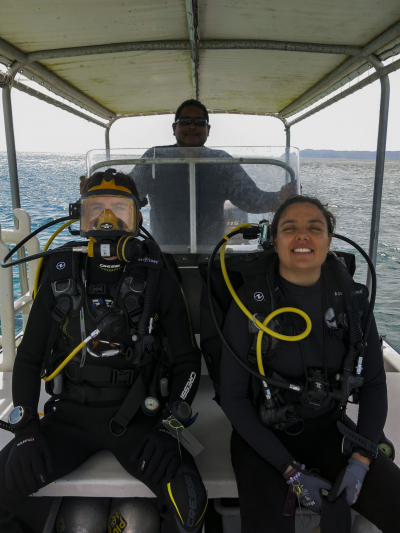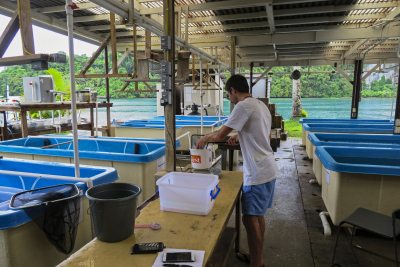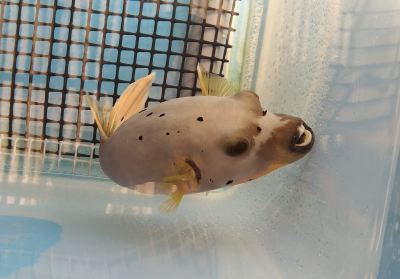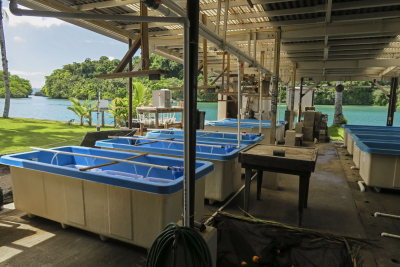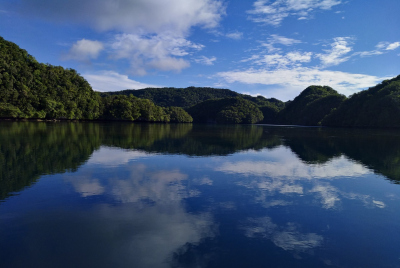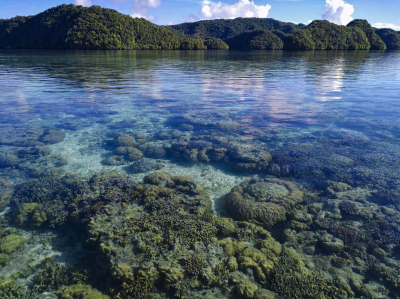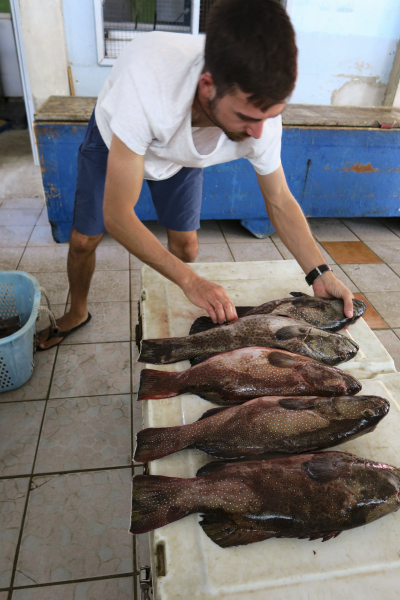- Graduate School GLOMAR
- PhD student reports
- Field Campaigns
- Mattia Ghilardi
Mattia Ghilardi
Report of GLOMAR PhD student Mattia Ghilardi about his field campaign in Palau from 01 November 2019 to 27 January 2020
On the 1st of November 2019 after a Halloween on the plane I landed in Palau, an island country in the western Pacific Ocean, with my supervisor Dr. Sonia Bejarano to conduct the first field campaign of my PhD project. This is part of a project called “REEF FUTURES - The future of reef services in the Anthropocene” which aims at quantifying present and future levels of five ecosystem services provided by reef fishes. Within this larger project, my PhD focuses on the contribution of reef fishes to the inorganic carbon cycle through the excretion of carbonates. In Palau I aimed to build a dataset of carbonate production rates covering numerous species and families by collecting carbonate pellets excreted by starved fishes kept in separate tanks at local environmental conditions.
During the next three months we stayed in Koror, the main city of Palau, where we were hosted by the Palau International Coral Reef Center (PICRC). This center provides great facilities to conduct research on coral reefs, including a large aquaria facility to perform experiments on fish, corals and other invertebrates. Since PICRC is located right next to Nikko Bay, characterized by extreme environmental conditions (low pH and salinity and high temperature) but relatively high coral cover and diversity, it is home to several research projects on coral adaptation to extreme environments. PICRC also manages the Palau aquarium, opened to locals and tourists and often used for educational purposes to teach local school students the importance of the coral reef, mangrove and seagrass ecosystems that dominate the coastal environment of Palau.
We spent the first ten days buying the extra material needed for the experiment, setting up our tanks and selecting sampling sites. We were only able to go out in the field after six days of strong wind and heavy rain as we were hit by the tail of typhoon Halong (several typhoons passed through the region during our stay bringing rain and wind in Palau). In the meantime we received the research permits needed for fish collection. On the 10th of November the other two members of our team, the dive mission leader and an ISATEC student, arrived in Palau and with the team reunited we were finally able to start our fieldwork.
In the next three weeks, before the departure of Dr. Bejarano and our dive mission leader, we focused mainly on the collection of samples and data for a project on cryptobenthic reef fishes led by Dr. Bejarano. During this period, however, I was able to perform the first collection of carbonates from 23 individual fishes. By the end of December, after spending numerous nights in the lab, I had carbonate samples from 145 individual fishes of 58 different species, distributed in 20 families.
Spending the Christmas season and New Year’s Eve in Palau was a bit strange since the thermometer never went below 25 degrees during our stay. Even though we were in a tropical place, it was still possible to feel part of the atmosphere we are used to in Europe, as Koror was covered by Christmas lights and decorations (much more than I see in my home town in Italy), including many inflatable snowmen! It is not easy to spend Christmas away from home for someone who has a large Italian family like me, but I was fortunate enough that my partner (also PhD student) was able to come and spend her holidays in Palau. Despite being on vacation, she spent most of her time helping us with field and laboratory work. We celebrated the New Year by diving into some of the best dive sites in the world.
In January, our stay at PICRC overlapped with the 19th anniversary of the research center. This meant that for two weeks we were unable to work in the laboratories because all the staff were involved in educational projects and in the preparation of the center’s 19th Anniversary Fundraising Gala Dinner. The Anniversary was a complete success with over 250 guests attending the gala dinner and over $250,000 raised to support the center. We took advantage of this time to collect data on the marketed reef fish species and the consumption preferences of the inhabitants of Palau by photographing fishes at the local fish market, gathering information on their prices and conducting interviews with customers, restaurants and hotels. These are valuable information that will be integrated in my project to classify species based on their ecological and socio-economic relevance in order to provide support for new and current conservation measures.
Now I am back in Bremen, where my samples will keep me busy for several weeks in the laboratory before I can start analyzing the data and seeing the first results of this work. The second field campaign is fast approaching and will take me to French Polynesia where I will conduct further experiments on the subject.
I would like to thank the BiodivERsA Belmont Forum and DFG for funding this work through the REEF FUTURES project and my supervisors Dr. Sonia Bejarano, Prof. Dr. Valeriano Parravicini, Dr. Sebastian Ferse, Dr. Tim Rixen and Prof. Dr. Christian Wild for their ongoing support and advice. A big thank you to Steffi, Pia and Ele for their great help in carrying out my work. Finally, I want to thank all the PICRC staff for their support and for all the fun moments that made this campaign unique.



